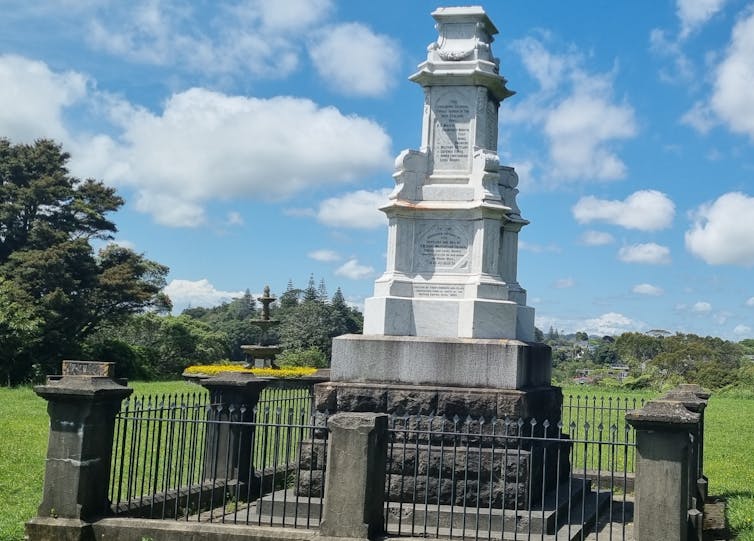Despite 2023 having been the sixth year a national day of commemoration for the New Zealand Wars was observed, it’s debatable how many New Zealanders really knew much about it.
Historians and Māori leaders are now worried about the mixed impact of the day – known as Te Pūtake o te Riri – amid wider fears it is already slipping from public attention.
The day was conceived as an important step towards greater public awareness of the major 19th-century conflicts between Māori and the settler government. It was first named He Rā Maumahara in 2016, “in honour of those who made sacrifices in wars and conflicts within Aotearoa New Zealand”.
The day was given its new name after consultation with iwi, and October 28 designated as the annual date of observance. Unlike Anzac Day, however, Te Pūtake o te Riri was not made an official holiday – and this may partly explain its struggle for wider recognition.
A question of timing
The day’s name is a compound of “Te Pūtake”, meaning the root or cause, and “te riri”, the anger or conflict. It emphasises Māori experiences, and each year’s commemoration is hosted by different hapū and iwi.
In 2023, for example, it focused on Ngai-te-rangi perspectives of the battle of Pukehinahina – “Gate Pā” – in Tauranga.
Despite an initial groundswell of interest and support, COVID inevitably disrupted observance of the day. But there have also been questions about the choice of October 28 in the first place.
From Parihaka to He Puapua: it’s time Pākehā New Zealanders faced their personal connections to the past
Historian Danny Keenan argues the date – which marks the signing in 1835 of He Whakaputanga, the Declaration of Independence – dilutes the focus on what were first and foremost military conflicts.
Sociologist and Māori educationalist Joanna Kidman also blames a lack of basic understanding by Pākehā New Zealanders of the New Zealand Wars, and the continued emphasis on World War I and other 20th-century conflicts.
Evolution of Anzac Day
The comparison with the first world war invites an intriguing question: what lessons might we learn from the history of our most visible war commemoration, Anzac Day?
In fact, April 25 itself has had its own ups and downs, shaped by New Zealanders’ shifting connection to the British Empire. The rhetoric and practice of a national commemoration, led by the prime minister, didn’t appear until the 1990s.
Indeed, in 1965, the 50th anniversary of Gallipoli, there were real doubts Anzac Day could survive the passing of the last Anzac veterans.
New lessons about old wars: keeping the complex story of Anzac Day relevant in the 21st century
Instead, it has survived as a sacred day – helped perhaps by the 1920 Anzac Day Act which made it an official public holiday. (The Act also banned public entertainment and other “profane” activities such as drinking in pubs and horse racing on April 25.)
The day’s remit was expanded in 1949 to commemorate all wars fought by New Zealand soldiers since the Boer War (1899-1902). But there was ongoing debate over whether the RSA and government had the right to make New Zealanders observe any particular “sacred” activity.
The law was liberalised in 1966 to allow people to do what they wanted after morning services ended at 11am. It was recognised that moving from solemnity to relaxation might avoid the risk of people simply rejecting the remembrance entirely.
Getty Images
War memorials and public memory
The growing public ownership of Anzac Day ran parallel to the decline of Armistice Day, which marked the end of the World War I on November 11.
On a par with April 25 until the 1940s, there was a near-immediate collapse in public support when the government moved observance to the nearest Sunday. This
suggests legislative status can be a significant factor in shaping attitudes to remembering the past.
The survival of Anzac Day, unlike November 11, also reflected the physical landscape of commemoration. No New Zealand town was too small to claim a local memorial to the fallen. As the sculptor Brett Graham has noted, war memorials became the dominant sculptural form of public life.
Nowadays, they are among the nation’s most prominent public sites, including the Auckland War Memorial Museum, the Pukeahu National War Memorial in Wellington, and Christchurch’s Bridge of Remembrance.
These memorial sites have retained their importance due to the efforts and investment of dedicated groups. Veterans and other social networks, expanded over the years to reflect a more diverse New Zealand, have been vital to the evolution of Anzac ritual.
Solidarity and difference — how Anzac Day reflects an ever-changing New Zealand
Gallipoli and national unity
Protests on Anzac Day (against war but also other social issues) also raised new questions about the purpose of the commemoration and its role in public life.
Significantly, the Gallipoli story – the central focus of our Anzac mythology – has been adapted and retold by each generation. Speeches, newspaper accounts, memoirs and official histories initially forged this mythical element, complete with heroes and martyrs, as well as villains (the German-Ottoman forces, later the British Empire itself).
In the 1980s, playwrights, documentary makers and film directors re-visualised the imperial Anzac story as appealing nationalist myths. Māori Television (Whakatā Māori) established a national Anzac Day broadcast in 2005, deepening the shared cultural languages and motifs of April 25.
Since the 1990s, successive governments – especially Helen Clark’s in the early 2000s – invested in Anzac Day as a commemoration of national unity.
A key milestone was the repatriation of the unknown warrior in 2004, observed by 100,000 New Zealanders who lined the streets of Wellington for the funeral procession and burial at Pukeahu. The state-funded Anzac Centenary in 2015 was the largest commemoration in New Zealand history.

Wikimedia Commons, CC BY-NC
Need for a national policy
What would a comparable state investment in New Zealand Wars commemoration look like? Some have suggested Te Pūtake o te Riri will never achieve the necessary public attention until it becomes a statutory holiday.
There are other challenges, too. As Joanna Kidman noted, many New Zealand Wars cemeteries, memorials and battlefields have been neglected or are on private land. Increasing public access to these sites will require a coordinated – and expensive – effort by local councils and central government.
It’s not enough, though, simply to transplant Anzac cultural and political symbols and language onto Te Pūtake o te Riri – an unknown warrior of our colonial conflicts, resting in Pukeahu’s Hall of Memories, for example.
Ngāti Maniapoto historian Kawhia Te Murahi has called for a unique “blending” of Māori and Pākehā tikanga and kawa for the day.
The issues raised all point to the need for a national policy on the commemoration of the New Zealand Wars – guided by iwi, with critical input from scholars – that enhances community relationships.
Learning to live with the ‘messy, complicated history’ of how Aotearoa New Zealand was colonised
New ways of remembering
In 2023, a striking example of the potential for war commemoration to take new directions took place at Te Rau Aroha, the museum at Waitangi dedicated to the contribution of Māori to the nation’s involvement in wars since 1840.
After its service on October 28, the museum hosted whānau descendants of 28th Māori Battalion veterans who had never claimed their medals for serving in World War II.
By choosing Te Pūtake o te Riri for the ceremony, the organisers were able to bridge past and present through themes of service, sacrifice and citizenship. As trusted institutions of public memory, museums are ideally placed to tell the stories of the New Zealand Wars.
Commemoration doesn’t happen by chance – it reflects the work of individuals, networks and institutions dedicated to promoting and framing a society’s defining narratives.
Both local initiative and state investment are important here. Above all, communities want to remember and commemorate the nation’s violent past. Anyone contributing to changes in public commemorative culture needs to understand this, and be guided by history.




